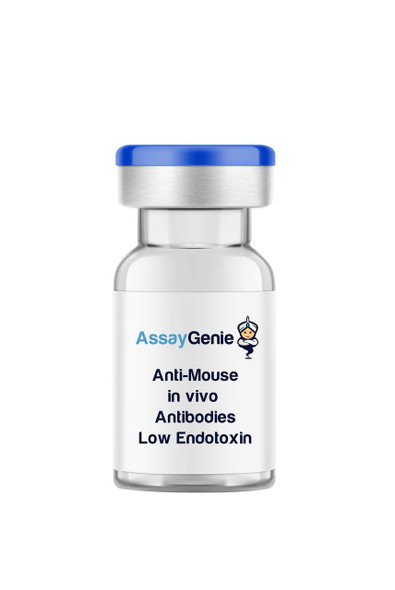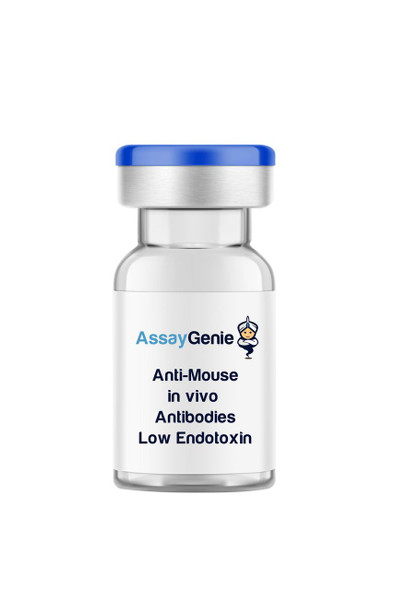Anti-Mouse CD155 (PVR) In Vivo Antibody - Low Endotoxin (IVMB0146)
- SKU:
- IVMB0146
- Antibody Type:
- Functional-Grade In Vivo Antibody
- Applications:
- In Vivo
- Disease Area:
- Cancer
- Clone:
- 4.24.1
- Protein:
- CD155
- Isotype:
- Rat IgG2a kappa
- Reactivity:
- Mouse
- Synonyms:
- PVR (poliovirus receptor) homolog
- Clone 4.24
- Research Area:
- Adhesion & Migration
- Endotoxin Level:
- Low Endotoxin
- Host Species:
- Rat
- FC
Description
Anti-Mouse CD155 (PVR) In Vivo Antibody - Low Endotoxin
Introducing the Anti-Mouse CD155/PVR In Vivo Antibody - Low Endotoxin from Assay Genie, a highly specific monoclonal antibody crafted for in vivo applications. This antibody specifically targets the CD155/PVR protein, a critical player in the immune system and tumor surveillance, making it indispensable for research in immunology, oncology, and related fields. Characterized by its high purity and low endotoxin levels (<1.0 EU/mg), it is optimized for multiple applications including ELISA, flow cytometry, and immunohistochemistry.
Available in various sizes, it is formulated in phosphate-buffered saline to ensure stability and effectiveness. Elevate your research with this dependable and adaptable antibody. CD155, also known as Poliovirus Receptor (PVR), is a transmembrane glycoprotein expressed in various tissues and plays a pivotal role in cell adhesion, migration, and immune responses. It is also involved in tumor immunology, acting as a ligand for immune checkpoint molecules such as DNAM-1.
| Product Name: | Anti-Mouse CD155 (PVR) In Vivo Antibody - Low Endotoxin |
| Product Code: | IVMB0146 |
| Size: | 1mg, 5mg, 25mg, 50mg, 100mg |
| Clone: | 4.24.1 |
| Protein: | CD155 |
| Product Type: | Monoclonal Antibody |
| Synonyms: | PVR (poliovirus receptor) homolog, Clone 4.24 |
| Isotype: | Rat IgG2a κ |
| Reactivity: | Mouse |
| Immunogen: | EL4 transfected with mouse CD155 |
| Applications: | FC |
| Formulation: | This monoclonal antibody is aseptically packaged and formulated in 0.01 M phosphate buffered saline (150 mM NaCl) PBS pH 7.2 - 7.4 with no carrier protein, potassium, calcium or preservatives added. |
| Endotoxin Level: | < 1.0 EU/mg as determined by the LAL method |
| Purity: | ≥95% monomer by analytical SEC >95% by SDS Page |
| Preparation: | Functional grade preclinical antibodies are manufactured in an animal free facility using only In vitro protein free cell culture techniques and are purified by a multi-step process including the use of protein A or G to assure extremely low levels of endotoxins, leachable protein A or aggregates. |
| Storage and Handling: | Functional grade preclinical antibodies may be stored sterile as received at 2-8°C for up to one month. For longer term storage, aseptically aliquot in working volumes without diluting and store at -80°C. Avoid Repeated Freeze Thaw Cycles. |
| Applications: | FC |
| Recommended Usage: | FC The suggested concentration for this 4.24.1 antibody for staining cells in flow cytometry is ≤ 0.25 µg per 106 in a volume of 100 µl. Titration of the reagent is recommended for optimal performance for each application. Each investigator should determine their own optimal working dilution for specific applications. See directions on lot specific datasheets, as information may periodically change. |
| Reactivity: | Mouse |
| Host Species: | Rat |
| Specificity: | Clone 4.24.1 recognizes an epitope on mouse CD155. |
| Antigen Distribution: | CD155 is expressed at cell junctions on the primary vascular endothelial cells and is highly expressed on DP thymocytes. |
| Immunogen: | EL4 transfected with mouse CD155 |
| Concentration: | ≥ 5.0 mg/ml |
| Endotoxin Level: | < 1.0 EU/mg as determined by the LAL method |
| Purity: | ≥95% monomer by analytical SEC >95% by SDS Page |
| Formulation: | This monoclonal antibody is aseptically packaged and formulated in 0.01 M phosphate buffered saline (150 mM NaCl) PBS pH 7.2 - 7.4 with no carrier protein, potassium, calcium or preservatives added. |
| Preparation: | Functional grade preclinical antibodies are manufactured in an animal free facility using only In vitro protein free cell culture techniques and are purified by a multi-step process including the use of protein A or G to assure extremely low levels of endotoxins, leachable protein A or aggregates. |
| Storage and Handling: | Functional grade preclinical antibodies may be stored sterile as received at 2-8°C for up to one month. For longer term storage, aseptically aliquot in working volumes without diluting and store at -80°C. Avoid Repeated Freeze Thaw Cycles. |
CD155 is a transmembrane glycoprotein member of a subfamily of immunoglobulin-like adhesion receptors (nectins). CD155 is commonly known as Poliovirus Receptor (PVR) because of its involvement as a cellular receptor for poliovirus. The normal function of CD155 is to establish intercellular adherens junctions between epithelial cells. Of its 3 extracellular immunoglobulin-like domains (D1, D2, and D3), the virus only recognizes D1. CD155 interacts with both CD226 and CD96 to induce cytotoxicity of NK cells and CTL. The precise role of CD155 in the immune system remains to be elucidated, though it is suspected to be involved in intestinal humoral immune responses. Furthermore, it is thought that CD155 may be used to positively select MHC-independent T cells in the thymus.
| Technical Datasheet: | View |
| Protein: | CD155 |
| Function: | Apart from its function of adhering junction among contacting epithelial cells, the interaction of DNAM-1 (CD226) with its ligands CD155 and CD112 (nectin 2) induces cytotoxcity of NK cells and CD8+ T cells and cytokine secretion. |
| Ligand/Receptor: | CD226 (DNAM-1), CD96 |
| Research Area: | Immunology, Innate Immunity |
Meet the team!
Shane Costigan
Territory Manager & Team Lead
Abdul Khadim
Sales Executive







